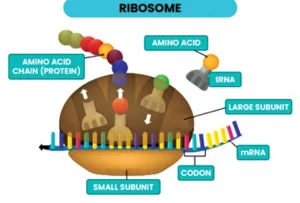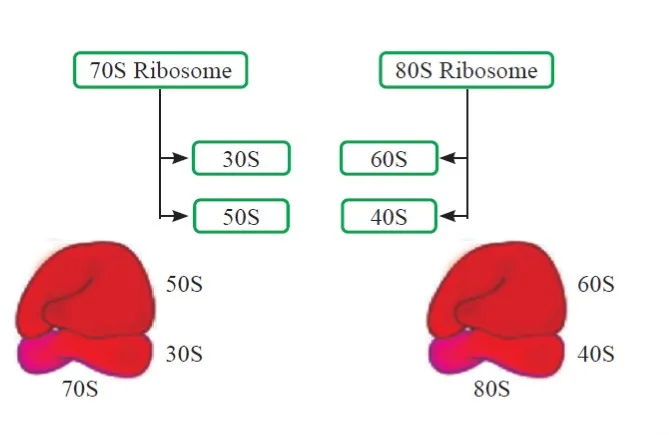
Ribosomes: Ribosomes are cellular machines that produce proteins. Each cell contains numerous ribosomes, each of which is made up of two parts. These parts encase and move along the messenger RNA, interpreting each three-letter codon. The ribosome serves as a connection point for transfer RNA molecules that correspond to the sequence of bases on messenger RNA.
Each three-letter codon in messenger RNA corresponds to a specific anticodon in transfer RNA. This specific RNA allows for the attachment of a specific amino acid to the growing protein chain. Once the protein is finished, the ribosome disassembles. The following article describes ribosomes in detail, including their definition, structure, composition, and functions.
What are Ribosomes?
The term "ribosome" is composed of two parts: "ribo" from ribonucleic acid and "somes" from the Greek word "soma," which means "body." Ribosomes are small, dense spherical particles ranging in diameter from 150 to 200 angstroms and can be found in prokaryotic and eukaryotic cells. They were first observed in plant cells by Robinson and Brown in 1953 and then in animal cells by Palade in 1955. Claude originally referred to them as microsomes; Palade coined the term "ribosomes" in 1955.
Ribosomes are complex molecular machines found within cells that synthesize proteins from amino acids in a process known as translation. They are essential for the conversion of genetic information carried by messenger RNA (mRNA) into proteins.
Ribosome-mediated protein synthesis has three stages: initiation, elongation, and termination. Ribosomal RNA (rRNA) in ribosomes aids in the peptidyl transferase reaction, which allows for the formation of peptide bonds between amino acids, ultimately leading to protein production. Proteins are synthesized in the ribosome and then transported throughout the cell to perform various functions.

Components of Ribososmes
Ribosomes are composed of two smaller parts that work together to convert messenger RNA (mRNA) into polypeptides and proteins through a process known as translation. Scientists frequently use density to describe ribosomes, which is defined as a molecule or particle's mass divided by its volume. Density is measured using Svedberg (S) units, which indicate how quickly particles settle during ultra-fast centrifugation. A higher S-value indicates that the particle is denser.
Ribosomes are composed of rRNA (ribosomal RNA) and protein. Prokaryotic cells (those without a nucleus) contain three types of rRNA: 23S rRNA, 16S rRNA, and 5S rRNA. Similar to transfer RNA (tRNA), rRNAs form complex folded structures by bonding matching nucleotide bases within a single strand of RNA.
Ribosomes are made up of two subunits, 50S and 30S. The 30S subunit contains 16S rRNA and 21 proteins, while the 50S subunit includes 5S, 23S rRNA, and 31 proteins. During protein synthesis, these subunits combine to form a full 70S ribosome measuring about 25 nanometers in width. A typical bacterium can contain up to 15,000 ribosomes.

Location of Ribosomes
Ribosomes can be found in either the cytoplasm or the endoplasmic reticulum of plant and animal cells. Their primary function is to convert DNA-encoded instructions into proteins. While some ribosomes are consistently bound to the rough endoplasmic reticulum, their connection is dependent on the proteins they help produce. In animal or human cells, up to 10 million ribosomes may be present. Furthermore, multiple ribosomes can associate with a single mRNA molecule at the same time, forming a structure known as a polysome.
Types of Ribosomes
Ribosomes exist in two forms, based on their size and sedimentation coefficient (S): 70S and 80S:
| Types of Ribosomes | ||
| Characteristic | 70S Ribosome | 80S Ribosome |
| Size | Smaller | Larger |
| Sedimentation Coefficient (S) | 70S | 80S |
| Molecular Weight | 2.7 × 10^6 daltons | 40 × 10^6 daltons |
| Found in | Prokaryotic cells of blue-green algae and bacteria. Mitochondria and chloroplasts of eukaryotic cells. | Eukaryotic cells, including plants and animals. |
| Additional Notes | Ribosomes in mitochondria and chloroplasts are smaller than cytoplasmic 80S ribosomes. | In yeast 80S ribosomes, 79 r-proteins are present, with only 12 r-proteins being specific. |
Characteristics of Ribosomes
Ribosomes are essential cellular structures involved in protein synthesis across all living organisms. Here are the key features of ribosomes:
- Presence in Various Organisms: Ribosomes are present in prokaryotic and eukaryotic organisms.
- Composition: Ribosomes are composed of ribonucleic acid (RNA) and proteins. The RNA component is known as ribosomal RNA (rRNA).
- Structure: Ribosomes consist of two subunits, a small subunit and a large subunit. These subunits collaborate during protein synthesis.
- Binding Sites: Ribosomes possess specific binding sites for molecules involved in protein synthesis.
- Cellular Localization: Ribosomes are located in two regions within the cell: dispersed throughout the cytoplasm and attached to the endoplasmic reticulum, forming the rough endoplasmic reticulum in some cases.
- Size Difference: Prokaryotes typically have 70S ribosomes, comprising a 50S large subunit 30S small subunit. In contrast, eukaryotes possess 80S ribosomes, with a 60S large subunit and a 40S small subunit.
Structure of Ribosomes
A ribosome is a complex structure consisting of both RNA and proteins, thus making it a ribonucleoprotein. The composition of a ribosome is approximately 37 to 62% RNA and the remaining portion is made up of proteins.
Ribosomes are divided into two subunits: a smaller subunit which binds to the mRNA pattern, and a larger subunit which binds to transfer RNA (tRNA), amino acids, and the smaller subunit.
Smaller Subunit: Binds to the mRNA pattern.
Composition:
- Prokaryotes (30S subunit): 16S RNA subunit bound to 21 proteins.
- Eukaryotes (40S subunit): Contains one 18S ribosomal RNA molecule and 30 proteins.
Larger Subunit: Binds to tRNA, amino acids, and the smaller subunit.
Composition :
- Prokaryotes (50S subunit): Includes a 5S RNA subunit, a 23S RNA subunit, and 31 proteins.
- Eukaryotes (60S subunit): Contains 28S, 5.8S, and 5S rRNA molecules, along with 40 proteins.
The differences between prokaryotic and eukaryotic ribosomes are used to develop antibiotics that target bacterial infections while causing no harm to human cells. Ribosomes, found in chloroplasts and mitochondria of eukaryotes, are made up of large and small subunits within a 70S particle.
Regardless of size, all ribosomes have a similar core structure. During protein synthesis, the two subunits work together to convert mRNA into a polypeptide chain. Ribosomes are slightly longer in one axis than in diameter because they are made up of two different-sized subunits.
Functions of Ribosomes
The ribosome is necessary for many cellular processes, the most important of which is protein synthesis. The following are the functions of ribosomes:
- Amino Acid Assembly: Ribosomes act as molecular machines, assembling amino acids into chains to form proteins. These proteins are essential for carrying out various cellular functions, including structural support, enzyme activity, and cell signalling.
- DNA Transcription: The genetic information stored in DNA is transcribed into messenger RNA (mRNA) through a process known as DNA transcription. This mRNA transports the genetic code from the nucleus to the cytoplasm, where protein synthesis takes place.
- mRNA Synthesis and Transport: mRNA synthesis takes place within the nucleus, where it is transcribed from DNA. After synthesis, mRNA is transported from the nucleus to the cytoplasm, where ribosomes reside.
- Ribosomal Binding: In the cytoplasm, ribosomal subunits bind to mRNAs. These ribosomes act as the machinery for protein synthesis, allowing amino acids to be assembled into polypeptide chains.
- Protein Synthesis: Transfer RNA (tRNA) molecules bring amino acids to the ribosome according to the instructions encoded in the mRNA. The ribosome then catalyzes the formation of peptide bonds between the amino acids, ultimately leading to the synthesis of proteins.
- Site of Protein Synthesis: Ribosomes are the primary site of protein synthesis within the cell. They function as translation factories, transforming genetic information encoded in mRNA into functional proteins.
- Utilization of Synthesized Proteins: Proteins synthesized in the cytoplasm are utilized within the cell for various cellular processes. Additionally, proteins synthesized by ribosomes bound to the endoplasmic reticulum (ER) are transported outside the cell, where they may perform functions such as cell signaling, structural support, or enzymatic activity in extracellular environments.
Protein Synthesis in Ribosomes
Protein synthesis occurs within cellular structures called ribosomes. This intricate process involves two main steps: transcription and translation.
Transcription
Definition: Transcription is the first step in protein synthesis where the genetic information stored in DNA is transcribed into messenger RNA (mRNA).
Process:
- Initiation: Enzymes unwind a segment of DNA, and RNA polymerase recognizes specific DNA sequences.
- Elongation: RNA polymerase joins complementary ribose nucleotides to form the mRNA strand.
- Termination: mRNA is synthesized, modified, and prepared for translation.
Translation
Definition: Translation is the second step where proteins are synthesized based on the genetic information carried by mRNA.
Process:
- Initiation: mRNA binds to a ribosomal subunit, forming an initiation complex with the first tRNA carrying methionine.
- Elongation: Amino acids are added to the growing polypeptide chain according to the codons on the mRNA.
- Termination: Translation halts when a stop codon is reached, leading to the release of the polypeptide chain.
Key Components:
- Transfer RNA (tRNA): Aligns amino acids according to mRNA codons.
- Ribosomes: Serve as the site for mRNA and tRNA binding.
Post-Translation Processing:
- Folding: The polypeptide may require further folding for its correct three-dimensional structure.
- Transport: Processed proteins are transported to their designated cellular locations.
Physics Wallah is well-known for offering NEET Online Coaching . Our main goal is to make learning affordable for all students. Through courses like Lakshya, Udaan, Arjuna, and more, we've helped thousands of aspiring students access quality education at a reasonable cost.
| NEET Exam Important Links | |
|---|---|
| NEET Biology Syllabus | NEET Biology Diagrams |
| NEET Biology MCQ | NEET Biology Chapter wise Weightage |
| NEET Biology Notes | NEET Previous Year Question papers |
Ribosomes FAQs
What is the function of ribosome?
Why are ribosomes called?
Who discovered ribosome?
What are ribosomes made of?
Is RNA or DNA the ribosome?










